(2: 长江水利委员会湖库水源地面源污染生态调控重点实验室, 武汉 430051)
(2: Key Laboratory of Ecological Regulation of Non-point Source Pollution in Lake and Reservoir Water Sources, Changjiang Water Resources Commission, Wuhan 430051, P.R.China)
河流水华具有暴发成因复杂、影响距离长等特点,通常以硅藻、甲藻等为优势藻种[1]. 全球一些大型河流曾经发生过大规模水华事件,例如澳大利亚的Darling河、北美的Saint Lawrence河、韩国的Nakdong河、匈牙利的Danube河等[2-4],以及国内的汉江、三峡入库支流、九龙江、龙江河和贺江等[5-6]. 当前对河流水华的研究认为,较高的营养盐浓度是河流水华暴发的必要条件[7-8],氮、磷、硅等营养盐浓度可以影响河流中浮游藻类的优势藻种,其中磷含量是很多大型河流暴发水华的一个限制因子[9-11]. 光照、气温、降水等气象条件也是影响浮游藻类聚生的重要环境因素,河流水华的暴发需要持续晴好天气的积累,有效降水和气温骤降则可能导致水华的突然消退[12]. 流量、流速等河流水文水动力条件影响浮游藻类的生长和空间分布[13],藻类生长对河道流速的响应主要表现为低流速促进、高流速抑制等特点[14-15],增大流量和流速可有效抑制水华暴发[16].
防控河流水华的最佳策略是降低河流营养盐浓度、减少污染输入,但这是一个长期的过程. 天气条件可以预测但是较难人工调控,因此水文水动力调控成为河流水华防控的首选途径[17]. 当前河流水华的防治仍然以上游水库下泄冲刷和稀释为主[18],但是由于河流抑制水华的关键水文过程和调控机制仍不明晰,抑制水华暴发和促进水华消退的下泄流量、下泄时机和调度时长等尚无法准确把握,同时水华发生时期通常处于水量较少的枯水期,能够用于下泄的水资源量十分有限[19],研究如何利用有限水量有效抑制河流水华,提高水华防控的水资源利用效率,达到水华防控与节水共赢目标,具有重要的现实需求.
汉江是长江最大支流,是沿岸城市生活和工农业用水的重要水源,上游的丹江口水库是南水北调中线工程调水水源地,中下游是襄阳、仙桃等城市饮用水水源地,其在国家水资源配置和汉江生态经济带发展中具有十分重要的地位,水质安全问题一直备受关注. 汉江中下游水华频发,自1992年春季首次暴发硅藻水华以来,至今已发生十余次水华事件. 汉江水华属于硅藻水华,暴发时间主要集中在春季1—3月份[20],水华发生河段大多在皇庄水文站以下的汉江下游,丹江口至皇庄区间的汉江中游河段水华发生频次较少. 汉江硅藻水华暴发时,水体呈棕褐色并散发腥臭味,藻类堵塞沿江水厂滤池,严重影响居民正常用水. 丹江口水库大坝加高蓄水和南水北调中线工程通水后,汉江中下游水文情势发生较大变化,兴隆等梯级水库建成运用使得非天然河段水动力作用减弱,为汉江中下游水华的发生提供了更为有利的水文水力条件[21]. 南水北调中线工程规划论证时(2001年),提出仙桃断面抑制水华暴发的生态流量为500 m3/s,但2015和2016年2次水华事件发生时仙桃水文断面的流量均超过了500 m3/s,最近2018和2021年均超过700 m3/s,汉江中下游暴发水华的流量、营养盐等条件仍在持续变化,调控水华面临新的挑战. 明确汉江中下游抑制水华暴发的水文水动力条件阈值及关键水文过程调控机制,对于减轻水华危害以及保障汉江中下游水生态和饮用水安全具有重要意义.
本研究通过系统统计历次水华事件发生情况,分析汉江中下游水华特征和暴发成因,探讨水华与水文过程的响应关系,提出抑制水华的关键指标和调控阈值,明确抑制水华的生态调度方式和持续时间,以期为汉江中下游防控水华生态调度实践提供技术支撑.
1 研究区域和方法 1.1 研究区域汉江是长江最大支流,丹江口以上为上游,丹江口至皇庄为中游,皇庄以下为下游. 本项目选取汉江中下游为研究区域(图 1),汉江中下游干流长652 km,流域面积6.38万km2,已建成王甫州、崔家营和兴隆3座低坝枢纽工程. 兴隆坝下高石碑处有引江济汉工程自长江引水注入汉江. 汉江下游自皇庄以下至河口,长382 km,位于江汉平原北部,地势平缓,河床比降小,平均比降仅为0.09 ‰,属于典型的平原长距离河道. 汉江中下游水系和典型研究断面位置如图 1所示.
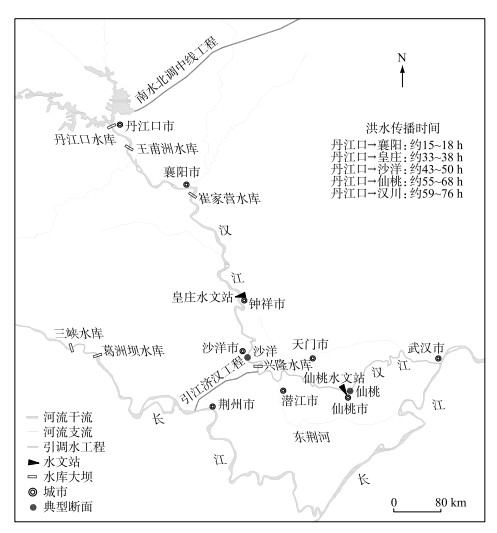
|
图 1 研究区水系与典型断面位置 Fig.1 Water system and location of typical cross-sections in the study area |
流量和水位分析采用皇庄、沙洋、仙桃等水文(水位)站1984—2018年长系列日均系列资料,水质和藻密度分析采用水华暴发期间应急监测数据. 发生水华年份与不发生水华年份1—3月份实测流量和水位多年平均系列差异分析采用对比统计方法,首先在长系列资料中摘录出每年1月1日—3月31日该段水华易发时期的日均流量或水位,其次筛选出发生水华年份1—3月数据组成系列A,不发生水华年份1—3月数据组成系列B,然后按照日期顺序求取逐日多年平均值组成新的系列C(发生水华年份)和系列D(不发生水华年份),最后对比分析发生水华年份逐日多年平均系列C和不发生水华年份系列D的差异. 流量或水位累积频率的计算方法是先筛选出水华发生年份1—3月逐日数据组成系列A,不发生水华年份1—3月数据组成系列B,从小到大进行排序后按照等区间值进行分组,计算各组内数据个数记为各组频数,各组频数与全部频数之和的比值为频率,然后采用向上累积的方式从变量值小的一方向变量值大的一方累加,频率的最终累积值为100 %.
采用Mike21模型模拟反演水华发生期间对应流量和水位条件下的断面平均流速. 以兴隆水库为界,分段建立平面二维水动力模型[21-22],其中皇庄至兴隆大坝江段长约108 km,兴隆坝下引江济汉运河口至仙桃江段长约100 km. 模型工况设置、上下边界条件和初始条件等见表 1,模型验证情况见表 2.
| 表 1 平面二维水动力模型边界条件 Tab. 1 Boundary conditions of plane two-dimensional hydrodynamic model |
| 表 2 模型准确性的检验标准 Tab. 2 Criteria for examining the accuracy of the model calibration and validation |
抑制水华生态调度效果采用断面生态需水满足率和硅藻生长适宜度指数等指标进行评价. 其中,断面生态需水满足率采用水华暴发月份断面实际流量满足阈值流量(有水华年份90 % 累积频率对应流量)天数与该月总天数的比值. 硅藻生长适宜度指数采用下式进行计算:
浮游植物生长适宜度指数=环境因子对应条件下藻密度水华暴发的临界藻密度,藻密度<107 cells/L时
| $ \text { 浮游植物生长适宜度指数 }= \begin{cases}\frac{\text { 环境因子对应条件下藻密度 }}{\text { 华暴发的临界藻密度 }}, & \text { 藻密度 }<10^{7} \text { cells } / \mathrm{L} \text { 时 } \\ 1, & \text { 藻密度 } \geqslant 10^{7} \mathrm{cells} / \mathrm{L} \text { 时 }\end{cases} $ | (1) |
式中,水华暴发的临界藻密度通常为107 cells/L.
2 结果 2.1 汉江中下游水华特征自1992年春季汉江首次发生水华以来,至今已累计暴发10余次较大规模的水华事件(表 3),近年来随着汉江中下游梯级水库运行对水文情势改变,以及城镇化发展引起入河污染物排放增加,汉江中下游水华暴发风险日益突出,给汉江的水环境、水生态和城市供水等带来许多不利影响.
| 表 3 汉江中下游历年水华发生情况统计 Tab. 3 Statistics on the occurrence of algal blooms in the middle and lower reaches of the Hanjiang River |
综合历次水华事件,汉江中下游水华主要呈现以下特点[23]:(1)时间上,大多发生在早春汉江枯水期,主要在1—3月份,以2月份最为集中;(2)空间上,发生区域主要分布在钟祥至河口江段,2014年之前无兴隆水库时,水华主要发生在潜江以下江段,2014年兴隆枢纽建成运行后,水华范围扩展至沙洋等兴隆库区江段;(3)水华发生时的优势藻种为汉斯冠盘藻(Stephanodiscus hantzschii),属于硅藻门、中心纲、圆筛藻目、圆筛藻科、冠盘藻属.
2.2 水华与水文水动力响应关系1992—2018年水文统计表明,汉江水华基本发生在1—3月份水量偏枯的年份,1—3月份水量越枯,发生水华的可能性越大(图 2),1—3月份来水频率小于40 % 的年份基本不发生水华. 发生和不发生水华年份1—3月多年日均流量、水位过程呈现出明显差异,发生水华年份的逐日平均流量小于不发生水华年份,逐日平均水位也明显低于不发生水华年份(图 3). 从逐日多年平均系列来看,发生水华年份平均流量范围约为550~700 m3/s,不发生水华年份平均流量范围约为800~950 m3/s.
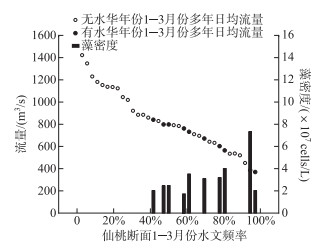
|
图 2 仙桃断面1992—2018年期间1—3月份平均流量水文频率及水华年份对应藻密度 Fig.2 The hydrological frequency of the average flow from January to March at the Xiantao section from 1992 to 2018, and the corresponding algae density in the year with algal bloom |
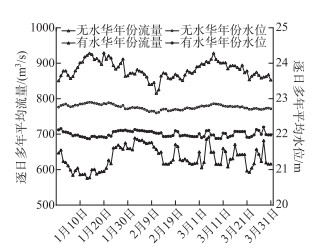
|
图 3 仙桃断面1992—2018年期间发生与不发生水华年份1—3月份日均流量(水位)过程 Fig.3 The average daily flow (water level) process at the Xiantao section from January to March in the years with and without algal blooms from 1992 to 2018 |
历史监测数据统计表明,汉江中下游水华暴发期间仙桃断面90 % 累积频率对应的流量为820 m3/s,水位为22.67 m(国家85高程,下同)(图 4),说明历次水华发生时90 % 的流量小于820 m3/s,这可能是连续晴好天气条件下预防水华发生的最小流量. 但是,一旦藻类积累到一定规模,藻密度接近水华暴发程度,仅仅依靠820 m3/s的流量将很难控制藻类快速增殖趋势,因为藻类的增殖呈现指数增长,必须通过更大的流量进行抑制.
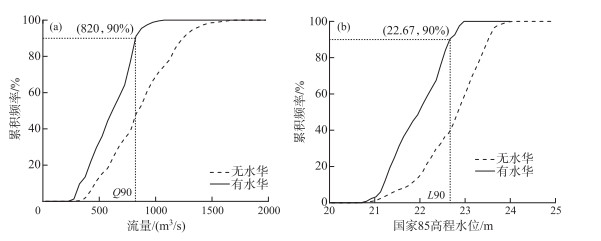
|
图 4 仙桃断面历次水华期间流量(a)和水位(b)累积频率分布 Fig.4 The cumulative frequency distribution of discharge (a) and water level (b) during the previous algal blooming periods at the Xiantao section |
河流水华的暴发与多种环境因素有关,当前对河流水华的研究普遍认为引起河流中浮游藻类大量增殖并暴发水华的环境因子主要包括营养盐、气象和水动力条件[24-25](图 5),其中营养盐是基础性限制因子,气象条件是诱导因子,水动力条件是主要驱动因子[26-27]. 高营养盐负荷、晴好天气和缓慢流速是导致汉江中下游水华暴发的主要原因[28].
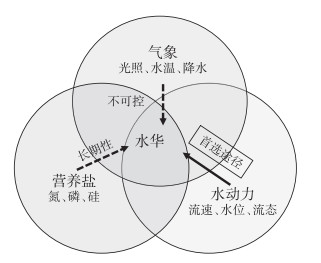
|
图 5 影响河流水华暴发的环境因素 Fig.5 Environmental factors affecting the outbreak of algal blooms in rivers |
1) 营养盐. 丹江口水库总氮(TN)背景浓度较高,氮源充足. 汉江中游钟祥磷矿镇附近总磷(TP)浓度较高,主要与汉江支流浰河汇入有关,该支流上游分布有磷矿企业,水质TP污染问题较为突出. 氮、磷营养条件齐备,为水华暴发提供了营养基础,其中TP浓度可能是影响水华分布范围的限制性因素[29];国外研究认为一般湖泊水体富营养化的TN阈值为0.65~1.2 mg/L,TP阈值为0.03~0.1 mg/L,而河流水体富营养化的TN阈值为>1.5 mg/L,TP阈值为>0.075 mg/L[30]. 根据这一阈值判断,皇庄以下的汉江下游江段氮、磷营养盐已达到富营养化水平,可为硅藻水华的暴发提供必要的基础营养条件(图 6).
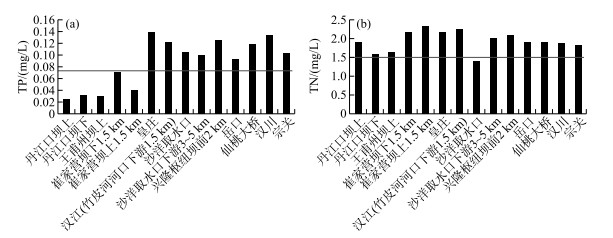
|
图 6 2018年水华期间汉江中下游总磷(a)和总氮(b)沿程变化(水平线代表河流富营养化氮磷指标临界值) Fig.6 Changes of TP (a) and TN (b) along the middle and lower reaches of the Hanjiang River during the algal bloom event in 2018 |
2) 气象条件. 春季气温偏高,硅藻生长加快,可促进水华暴发;光在水中的光谱梯度变化是藻类竞争演替的重要基础. 光强应答机制的生理学研究表明,汉斯冠盘藻具有广泛的光适应性,在光照强度为5~50 μE/(m2·s)通量范围内,均能较快进入指数生长期[31];降水引起河水浊度上升,干扰藻类在水体表层聚生,容易引起水华突然消退. 气象资料统计表明,汉江中下游发生水华年份早期最高气温持续超过10℃,有些年份甚至超过20℃,为硅藻快速增殖提供了适宜的光照和气温环境.
3) 水动力条件. 河流中浮游藻类生物量与流量呈反比[32-34],增大流量和流速可以有效增加垂向和纵向水流的交换能力,增加水流对藻类表面的剪切应力,缩短浮游藻类在河段中的传输和滞留时间,抑制藻类生长,使其无法大量聚集,从而抑制水华暴发[18]. 春季枯水期低流量和低流速是汉江中下游水华暴发的重要原因;长江武汉段部分年份水位较高,对汉江水位产生顶托作用,使得汉江水流速度减缓,也对水华发生有一定的促进作用. 历史数据统计表明,发生水华年份比未发生水华的年份同期水位差低0.86~5.26 m[35]. 在氮、磷等营养盐充足的情况下,汉江历年光照和气象等条件相比变化不大,枯水期长江水位顶托和上游水利工程调度对汉江中下游水动力条件的改变形成了有利于浮游藻类聚集生长的水流环境,这种特殊水动力条件变化可能是驱动水华暴发的主要因素.
3.2 防控水华关键指标及其阈值影响水华暴发的主要环境因子中,天气和水温基本不具有可调节性,氮、磷营养盐可以通过控源减排等管理方式进行人工调控,但是短期内效果不明显,需要长期的水污染防治. 相比而言,流量、水位、流速等水文水力指标具有可调控能力强、短期内抑制水华效果明显等特点. 河流防控水华的关键指标包括氮磷营养盐、流量、流速、水位等,这些关键指标中流量、水位和流速等水文水动力指标可通过水库生态调度进行调节. 本研究将流速、流量和水位指标作为低坝枢纽河库系统生态需水调控的最主要指标,同时考虑氮、磷营养盐指标的控源减排等管理措施.
根据浮游藻类生物学特性,流量的变化主要通过流速变化来影响浮游藻类聚生,因此研究水华暴发和消退初期的断面流速情况,进而推导出该流速值对应的流量,以此确定抑制水华所需的流量条件可能更具合理性. 采用Mike21模型对历次水华发生期间流速分布情况进行模拟反演,模拟结果表明,水华暴发初期仙桃和沙洋断面平均流速范围分别为0.25~0.46和0.10~0.13 m/s,水华暴发持续一段时间后开始消退时仙桃和沙洋断面平均流速范围分别为0.43~0.67和0.14~0.20 m/s. 仙桃和沙洋断面水华开始消退时期流速最大的年份出现在2018年,分别为0.67和0.20 m/s(图 7,表 4). 由此确定,仙桃自然河段和兴隆库区河段抑制水华生态需水调控的流速阈值分别为0.67和0.20 m/s.
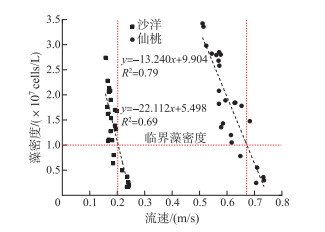
|
图 7 沙洋和仙桃断面临界藻密度与临界流速(细虚线为临界值) Fig.7 Threshold algae density and threshold velocity at the Shayang and Xiantao sections |
| 表 4 沙洋和仙桃断面历次水华期间水华暴发初期和消退初期流量与水位值统计 Tab. 4 Statistics of flow and water level values at the beginning of the algal bloom outbreak and the initial period of subsidence at the Shayang and Xiantao sections |
兴隆水库为径流式日调节水库,水库基本维持正常蓄水位36.2 m运行,采用Mike21模型模拟结果表明,36.2 m正常蓄水位条件下库尾沙洋断面0.20 m/s流速对应的入库流量约为1160 m3/s,因此沙洋断面流速阈值对应的流量条件为1160 m3/s. 仙桃河段为自然河段,受下游长江水位顶托作用,在不同水位条件下,抑制水华流速阈值对应的流量条件不唯一,范围约为1040~1200 m3/s(图 8).

|
图 8 不同特征水位下仙桃断面流量-流速关系曲线(细虚线为临界值) Fig.8 Flow-velocity relationship curve of Xiantao section under different characteristic water levels |
综上所述,以90 % 累积频率对应的流量和水位条件作为水华预警阈值,即仙桃断面流量低于820 m3/s同时水位低于22.67 m时,可启动水华预警. 根据汉江中下游多个断面叶绿素a浓度与藻密度的关系,推测叶绿素a浓度超过30 μg/L时,藻密度接近临界值107 cells/L,因此当叶绿素a浓度超过30 μg/L时也可作为水华预警启动条件. 在调控阈值方面,以水华消退初期最大平均流速及其对应的流量条件作为水华调控阈值,其中沙洋断面代表兴隆库尾控制水华的水文水动力阈值,流速和入库流量阈值分别为0.2 m/s和1160 m3/s,仙桃断面代表兴隆水库以下自然河段控制水华的水文水动力阈值,流速阈值为0.67 m/s,对应不同长江壅水条件下的流量阈值在1040~1200 m3/s范围内变化. 为了使兴隆库区水体尽快达到0.2 m/s阈值流速,缩短来水滞留时间,兴隆库区宜采用水位波动式方式. Mike21模拟结果表明,使库尾沙洋断面流速达到0.2 m/s阈值条件的水位日变化幅度范围为0.5~1.5 m/d(表 5). 此外,根据河流水华富营养化阈值[30],总磷和总氮浓度阈值分别定为0.075和1.5 mg/L. 汉江中下游抑制水华生态调度指标及其阈值成果见表 6.
| 表 5 兴隆库区沙洋断面平均流速对水位波动的响应 Tab. 5 Response in the average velocity of the Shayang section to water level fluctuations in front of the Xinglong Dam |
| 表 6 汉江中下游抑制水华生态调度指标及其阈值 Tab. 6 Indexes and thresholds of ecological regulation for algal bloom control in the middle and lower reaches of the Hanjiang River |
根据相关水文资料整编成果,汉江干流丹江口坝下至襄阳江段的洪水传播时间为15~18 h,至皇庄为33~38 h,至沙洋为43~50 h,至仙桃为55~68 h,至汉川为59~76 h. 丹江口水库加大下泄流量后形成的洪峰最快需要2 d左右才能到达兴隆库区. 因此,对汉江下游江段实施抑制水华生态调度时必须考虑洪水传播时间等因素,在丹江口水库加大下泄流量到达水华暴发河段之前,需要优先考虑启动兴隆水库调度和加大引江济汉工程引水流量.
汉江中下游抑制水华生态调度围绕丹江口水库、汉江中下游梯级(兴隆水库为主)和引江济汉工程联合开展(图 9),生态调度方案为:(1)条件允许情况下,兴隆水库可首先采用敞泄式调度方式,将库区水体全部更换,使库区积累的藻类尽快排出,换水完成后尽快蓄水至正常蓄水位,减小发电损失;在兴隆水库蓄水期间,减少的下泄流量应由引江济汉工程补足;(2)当敞泄式调度存在困难时,兴隆水库应优先采用水位波动式(冲蓄结合)调度方式进行调度,同时丹江口水库加大下泄流量至800 m3/s,使兴隆入库流量逐步达到1000~1160 m3/s,王甫洲、崔家营等梯级水利枢纽尽量采用低水位运行,确保丹江口下泄水量尽快到达兴隆库区,兴隆枢纽采用水位波动式(冲蓄结合)调度方式,坝前水位波动范围为0.5~1.5 m/d;当兴隆入库流量超过1160 m3/s时,水位波动幅度可降低至0.5 m/d以下;(3)加大引江济汉工程引水,引水流量能够补充上游兴隆枢纽水位抬升时期减少的下泄流量,丹江口水库下泄、兴隆水库水位调节和引江济汉工程引水三者共同保障到达仙桃断面的流量不低于1040~1200 m3/s(对应不同水位).

|
图 9 汉江中下游抑制水华联合生态调度示意图 Fig.9 Schematic diagram of the joint ecological regulation for algal bloom control in the middle and lower reaches of the Hanjiang River |
在生态调度持续时间方面,研究表明汉江中下游气温高于同期3℃且持续5 d以上时,暴发水华的概率大为增加[29]. 同时根据2018年水华应急调度效果,仙桃断面流量连续5 d超过1000 m3/s时水华开始消退. 因此,汉江中下游通过联合调度使得沙洋和仙桃断面达到阈值流量(沙洋≥1160 m3/s和仙桃≥1040~1200 m3/s)的持续时间适宜以5 d为一个周期,视水华消退情况再行决定是否开展第二轮联合生态调度. 同时应密切关注天气预报情况,若未来几日有明显降温或降雨过程,将对水华消退有良好促进作用,丹江口水库下泄水量和引江济汉工程引水水量应根据情况实时进行减量调整.
3.4 抑制水华生态调度效果2021年1月12日以后汉江中下游表征浮游藻类生物量的指标叶绿素a浓度迅速升高,仙桃断面1月15日突破30 μg/L警戒值,1月18日超过了60 μg/L. 兴隆水库自1月19日起开展应急调度,采用水位波动式“冲蓄结合”的调度方式,兴隆下游仙桃断面叶绿素a浓度开始下降. 2021年1月24日—29日丹江口水库按照800 m3/s向汉江下游加大供水流量,30日恢复至620 m3/s,进一步促进了叶绿素a浓度下降,有效遏制了水华发展趋势. 经监测判定本次为轻度水华,藻密度最高为2.0×107 cells/L(1月23日宗关断面).
抑制水华生态调度实施后,汉江中下游仙桃断面叶绿素a浓度从80 μg/L下降至30 μg/L,藻密度从2.0×107 cells/L下降至0.8×107 cells/L;调度后硅藻生长适宜度指数从0.88下降至0.2,仙桃断面生态需水满足率提高了19.4 %,生态调度效果十分显著(图 10).
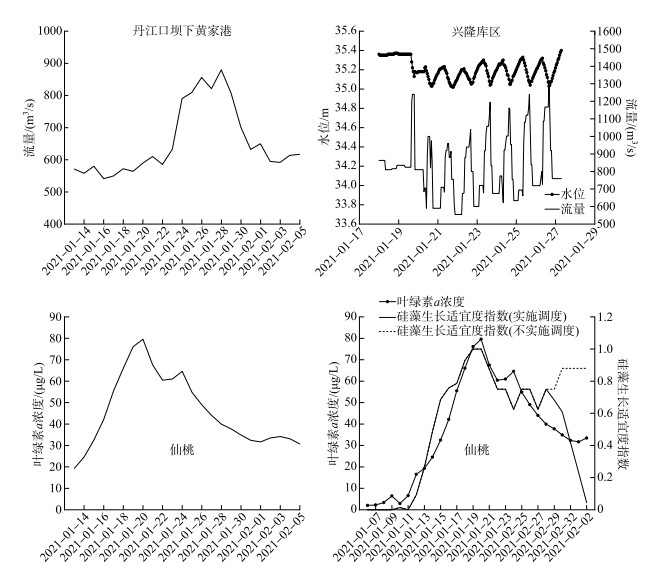
|
图 10 2021年生态调度过程及抑制水华效果:(a)调度期间丹江口水库下泄流量超过800 m3/s;(b)兴隆水库采用水位波动式(冲蓄结合)调度;(c)调度后仙桃断面叶绿素a浓度明显下降;(d)实施生态调度与不实施生态调度情景下硅藻生长适宜度对比 Fig.10 The process of ecological regulation in 2021 and the effect of suppressing algal blooms: (a) The water discharge released from Danjiangkou Reservoir exceeded 800 m3/s during the regulation period; (b) Xinglong Reservoir adopts water level fluctuation operation (combined release and storage); (c) The chlorophyll-a concentration of Xiantao section decreased significantly after regulation; (d) Comparison of the suitability of diatom growth under the scenarios of implementing ecological regulation and not implementing ecological regulation |
汉江中下游水华暴发与营养盐、气象和水动力等多种环境因素有关,水华暴发成因复杂. 汉江中下游水华主要发生在1—3月份,以2月份最为集中,兴隆水库修建后水华发生河段已经从潜江以下向上游扩展至兴隆库区,兴隆水库成为硅藻水华暴发的重要藻源聚集地. 皇庄以下的汉江下游江段氮、磷营养盐充足,可为硅藻水华暴发提供必要的基础营养条件;水华暴发时期天气晴好,最高气温持续高于10℃,为硅藻快速增殖提供了适宜的光照和气温环境;发生水华年份汉江下游流量(流速)明显小于不发生水华年份;由于河道特征差异,可能不存在统一的抑制水华的临界流速(流量)阈值,兴隆库区河段和仙桃自然河段抑制水华的临界流速阈值分别为0.20和0.67 m/s,分别对应沙洋流量1160 m3/s、仙桃流量1040~1200 m3/s;丹江口水库加大下泄流量、兴隆水库水位波动式调节和引江济汉工程加大引水是抑制水华的关键调度方式;汉江中下游气温高于同期3℃且持续5 d以上时,汉江中下游暴发水华的概率大为增加,汉江中下游联合生态调度适合以5 d为一个调度周期.
汉江中下游水华需要从多方面联合防控. 其中,控源减排是根本,应加强汉江中下游总磷污染防治;建议加强水文水质监测和科学研究,进一步明确河流水华生消机制,做到对水华的科学防控,充分发挥梯级水库和引调水工程调节能力,科学优化调度方案,通过科学研究和生态调度实践实现从应急调度向预报调度转变,实现水资源高效利用与防控水华双重目标.
| [1] |
Yang Q, Xie P, Xu J et al. Research advances of diatom blooms in rivers. Resources and Environment in the Yangtze Basin, 2011, 20(S1): 159-165. [杨强, 谢平, 徐军等. 河流型硅藻水华研究进展. 长江流域资源与环境, 2011, 20(S1): 159-165.] |
| [2] |
Schmidt A. Main characteristics of the phytoplankton of the Southern Hungarian section of the River Danube. Hydrobiologia, 1994, 289(1/2/3): 97-108. DOI:10.1007/BF00007412 |
| [3] |
Donnelly TH, Grace MR, Hart BT. Algal blooms in the Darling-Barwon River, Australia. Water, Air, and Soil Pollution, 1997, 99(1/2/3/4): 487-496. DOI:10.1007/BF02406888 |
| [4] |
Weise AM, Levasseur M, Saucier FJ et al. The link between precipitation, river runoff, and blooms of the toxic dinoflagellate Alexandrium tamarense in the St. Lawrence.. Canadian Journal of Fisheries and Aquatic Sciences, 2002, 59(3): 464-473. DOI:10.1139/f02-024 |
| [5] |
Liu DF, Yang ZJ, Ji DB et al. A review on the mechanism and its controlling methods of the algal blooms in the tributaries of Three Gorges Reservoir. Journal of Hydraulic Engineering, 2016, 47(3): 443-454. [刘德富, 杨正健, 纪道斌等. 三峡水库支流水华机理及其调控技术研究进展. 水利学报, 2016, 47(3): 443-454.] |
| [6] |
Yang M, Zhang S, Hu ZY. Characteristics and preliminary regulating factors of cyanobacterial bloom in Xiangxi Bay of the Three Gorges Reservoir. J Lake Sci, 2014, 26(3): 371-378. [杨敏, 张晟, 胡征宇. 三峡水库香溪河库湾蓝藻水华暴发特性及成因探析. 湖泊科学, 2014, 26(3): 371-378. DOI:10.18307/2014.0306] |
| [7] |
Hilton J, O'Hare M, Bowes MJ et al. How green is my river? A new paradigm of eutrophication in rivers. Science of the Total Environment, 2006, 365(1/2/3): 66-83. DOI:10.1016/j.scitotenv.2006.02.055 |
| [8] |
Xia R, Zhang Y, Wang GS et al. Multi-factor identification and modelling analyses for managing large river algal blooms. Environmental Pollution, 2019, 254: 113056. DOI:10.1016/j.envpol.2019.113056 |
| [9] |
Olley J, Caitcheon G. Major element chemistry of sediments from the Darling-Barwon River and its tributaries: Implications for sediment and phosphorus sources. Hydrological Processes, 2000, 14(7): 1159-1175. DOI:10.1002/(SICI)1099-1085(200005)14:7<1159::AID-HYP6>3.0.CO;2-P |
| [10] |
Mhamdi BA, Azzouzi A, Mhamdi MA et al. Dynamics of the relative nitrogen and phosphorus concentrations in a reservoir situated in a semi-arid zone (Sahela, Morocco). Water Resources Management, 2007, 21(6): 983-995. DOI:10.1007/s11269-006-9068-5 |
| [11] |
Chislock MF, Sharp KL, Wilson AE. Cylindrospermopsis raciborskii dominates under very low and high nitrogen-to-phosphorus ratios. Water Research, 2014, 49: 207-214. DOI:10.1016/j.watres.2013.11.022 |
| [12] |
Jiang X, Jin XC, Yao Y et al. Effects of biological activity, light, temperature and oxygen on phosphorus release processes at the sediment and water interface of Taihu Lake, China. Water Research, 2008, 42(8/9): 2251-2259. DOI:10.1016/j.watres.2007.12.003 |
| [13] |
Whitehead PG, Wilby RL, Battarbee RW et al. A review of the potential impacts of climate change on surface water quality. Hydrological Sciences Journal, 2009, 54(1): 101-123. DOI:10.1623/hysj.54.1.101 |
| [14] |
Mao JQ, Jiang DG, Dai HC. Spatial-temporal hydrodynamic and algal bloom modelling analysis of a reservoir tributary embayment. Journal of Hydro-Environment Research, 2015, 9(2): 200-215. DOI:10.1016/j.jher.2014.09.005 |
| [15] |
Kim J, Lee T, Seo D. Algal bloom prediction of the lower Han River, Korea using the EFDC hydrodynamic and water quality model. Ecological Modelling, 2017, 366: 27-36. DOI:10.1016/j.ecolmodel.2017.10.015 |
| [16] |
Anggara Kasih GA, Kitada T. Numerical simulation of water quality response to nutrient loading and sediment resuspension in Mikawa Bay, central Japan: Quantitative evaluation of the effects of nutrient-reduction measures on algal blooms. Hydrological Processes, 2004, 18(16): 3037-3059. DOI:10.1002/hyp.5748 |
| [17] |
Palmer M, Ruhi A. Linkages between flow regime, biota, and ecosystem processes: Implications for river restoration. Science, 2019, 365(6459): eaaw2087. DOI:10.1126/science.aaw2087 |
| [18] |
Yang Q, Xie P, Shen H et al. A novel flushing strategy for diatom bloom prevention in the lower-middle Hanjiang River. Water Research, 2012, 46(8): 2525-2534. DOI:10.1016/j.watres.2012.01.051 |
| [19] |
Cheng BF, Xia R, Zhang Y et al. Characterization and causes analysis for algae blooms in large river system. Sustainable Cities and Society, 2019, 51: 101707. DOI:10.1016/j.scs.2019.101707 |
| [20] |
Wang J, Wang JC, Xu JQ et al. Causes analysis of water bloom in middle and lower reaches of Hanjiang River in 2018 and its countermeasures. Yangtze River, 2018, 49(17): 7-11. [王俊, 汪金成, 徐剑秋等. 2018年汉江中下游水华成因分析与治理对策. 人民长江, 2018, 49(17): 7-11.] |
| [21] |
Xin XK, Wang YC, Hu S et al. Cause analysis of diatom bloom of lower reaches of Hanjiang River in 2018. Water Resources and Power, 2019, 37(3): 25-28. [辛小康, 王英才, 胡圣等. 2018年汉江下游硅藻水华成因分析. 水电能源科学, 2019, 37(3): 25-28.] |
| [22] |
Li J, Yin W, Jia HY et al. Hydrological management strategies for the control of algal blooms in regulated lowland rivers. Hydrological Processes, 2021, 35(6): e14171. DOI:10.1002/hyp.14171 |
| [23] |
Li J, Yin W, Jia HY et al. Research progress on diatom blooms in the middle and lower Hanjiang River: Review and advances. Journal of Hydroecology, 2020, 41(5): 136-144. [李建, 尹炜, 贾海燕等. 汉江中下游硅藻水华研究进展与展望. 水生态学杂志, 2020, 41(5): 136-144. DOI:10.15928/j.1674-3075.2020.05.016] |
| [24] |
Huisman J, Codd GA, Paerl HW et al. Cyanobacterial blooms. Nature Reviews Microbiology, 2018, 16(8): 471-483. DOI:10.1038/s41579-018-0040-1 |
| [25] |
Xia R, Wang GS, Zhang Y et al. River algal blooms are well predicted by antecedent environmental conditions. Water Research, 2020, 185: 116221. DOI:10.1016/j.watres.2020.116221 |
| [26] |
Neal C, Hilton J, Wade AJ et al. Chlorophyll-a in the rivers of eastern England. Science of the Total Environment, 2006, 365(1/2/3): 84-104. DOI:10.1016/j.scitotenv.2006.02.039 |
| [27] |
Lynam CP, Cusack C, Stokes D. A methodology for community-level hypothesis testing applied to detect trends in phytoplankton and fish communities in Irish waters. Estuarine, Coastal and Shelf Science, 2010, 87(3): 451-462. DOI:10.1016/j.ecss.2010.01.019 |
| [28] |
Yin DC, Yin ZJ, Yang CH et al. Key hydrological thresholds related to algae bloom in middle and lower reaches of Hanjiang River and studies on mitigation measures. China Water Resources, 2017(9): 31-34. [殷大聪, 尹正杰, 杨春花等. 控制汉江中下游春季硅藻水华的关键水文阈值及调度策略. 中国水利, 2017(9): 31-34.] |
| [29] |
Xin XK, Zhang H, Lei P et al. Algal blooms in the middle and lower Han River: Characteristics, early warning and prevention. Science of the Total Environment, 2020, 706: 135293. DOI:10.1016/j.scitotenv.2019.135293 |
| [30] |
Smith VH, Tilman GD, Nekola JC. Eutrophication: impacts of excess nutrient inputs on freshwater, marine, and terrestrial ecosystems. Environmental Pollution, 1999, 100(1/2/3): 179-196. DOI:10.1016/S0269-7491(99)00091-3 |
| [31] |
Zheng LL. The physiological and ecological research about the dominant species in Hanjiang River diatom bloom [Dissertation]. Fuzhou: Fujian Normal University, 2005. [郑凌凌. 汉江硅藻水华优势种生理生态学研究[学位论文]. 福州: 福建师范大学, 2005 ]
|
| [32] |
Filardo MJ, Dunstan WM. Hydrodynamic control of phytoplankton in low salinity waters of the James River Estuary, Virginia, USA. Estuarine, Coastal and Shelf Science, 1985, 21(5): 653-667. DOI:10.1016/0272-7714(85)90064-2 |
| [33] |
Mosley LM, Zammit B, Leyden E et al. The impact of extreme low flows on the water quality of the lower Murray River and lakes (south Australia). Water Resources Management, 2012, 26(13): 3923-3946. DOI:10.1007/s11269-012-0113-2 |
| [34] |
Klaus J, Wetzel CE, Martínez-Carreras N et al. A tracer to bridge the scales: On the value of diatoms for tracing fast flow path connectivity from headwaters to meso-scale catchments. Hydrological Processes, 2015, 29(25): 5275-5289. DOI:10.1002/hyp.10628 |
| [35] |
Wang HP, Xia J, Xie P et al. Mechanisms for hydrological factors causing algal blooms in Hanjing River—based on kinetics of algae growth. Resources and Environment in the Yangtze Basin, 2004, 13(3): 282-285. [王红萍, 夏军, 谢平等. 汉江水华水文因素作用机理——基于藻类生长动力学的研究. 长江流域资源与环境, 2004, 13(3): 282-285.] |
 2022, Vol. 34
2022, Vol. 34 

